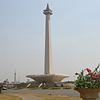 | 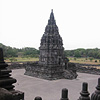 | 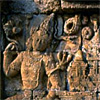 |
The main destination areas contain many of these places of interest which are easily accessible.
 |  |  |
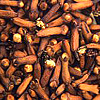 | 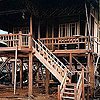 |
The country is rich in natural resources While 90% of the population is engaged in agriculture, oil and gas contribute 70% of total export earnings and 60% of the government revenues.
However, fluctuations in world prices of traditional export commodities have led to a change in recent years in the structure of the economy. Tourism is gaining a more important sector as a foreign exchange earner. To production and growth in the industry, the government has formulated new policies and improved facilities. Significant progress has been made in communications and transportation and since 1976, Indonesia has had its own communications satelite system which has enabled rapid expansion of telephone, television and broadcast facilities to all 27 provinces.
Air and sea ports are being extended to cater to the growing traffic on both domestic and international sectors, of passengers as well as freight.
Besides oil and liquefied natural gas (LNG), forestry products, rubber, coffee, tea, tin, nickel, coper, palm products and fish make important contributions to export earnings. In recent years a number of steps have been taken to promote and stimulate non-oil exports which include handicrafts, textiles, precious metals, tea, tobacco, cement, fertilizers as well as manufactured goods.
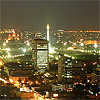 |  |  |
 |  |  |
 | 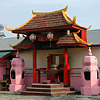 | 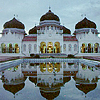 |
 | 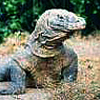 |  |
British naturalist A. R. Wallace (1823-1931) postulated an imaginary line (named after him Walace's Line) as the dividing line between Asiatic and Australian fauna. It passes between Bali and Lombok islands between Kalimantan and Sulawesi, then continues south of the Philippines and north of Hawaii.
This theory probably explains the presence of species of fauna familiar to both Asia and Australia found in Indonesia. However, there are species indigenous to Indonesia, like the "orang utan" apes of Sumatra and Kalimantan, the giant "komodo" lizards which are the only ones of their kind in the world today roaming free on the island of Komodo; the one homed rhinoceros of Java, the wild "banteng" oxen, tigers and many other species which are now protected in wildlife reserves.
The flora of Indonesia ranges from the tiny orchid to the giant "Rafflesia" plant which has a bloom almost a metre (3.2 feet) in diameter the largest flower in the world and many other species of plant life which can be seen at the Bogor Botanical Gardens.
 | 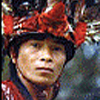 | 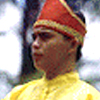 |
 |  |  |
The Capital City
The nation's capital, Jakarta, has a fascinating and significant history. It started as a small harbour town called Sunda Kelapa, but its founding dates back to the year 157 when it was named Jayakarta by Fatahillah of the neighbouring Sultanate of Banten.
The name Jayakarta means City of Great Victory but this was later changed to Batavia under the Dutch. Now as Jakarta, the centre of government, business and industry, it spreads over an area of more than 650 sq.km 1410 sq miles) and has a population of over eight million people.
It is also designated as a special territory, (Daerah Khusus Ibukota - DKI), which means that is is administered by a governor and enjoys the same status of a province.
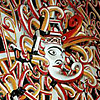 | 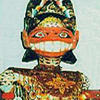 | 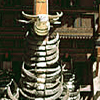 |
Indonesia is rich in art and culture which are intertwined with religion and age-old traditions from the time of early migrants with Western thoughts brought by Portuguese traders and Dutch colonists. The basic principles which guide life include the concepts of mutual assistance or "gotong royong" and consultations or "musyawarah" to arrive at a consensus or "mufakat" Derived from rural life, this system is still very much in use in community life throughout the country.
Though the legal system is based on the old Dutch penal code, social life as well as the rites of passage are founded on customary or "adat" law which differs from area to area. "Adat" law has a binding impact on Indonesian life and it may be concluded that this law has been instrumental in maintaining equal rights for women in the community. Religious influences on the community are variously evident from island to island.
Symbolism
The national motto, Bhinneka Tunggal Ika, is an old Javanese expression usually translated as "unity in diversity." The nation's official ideology, first formulated by President Sukarno in 1945, is the Pancasila, or Five Principles: belief in one supreme God; just and civilized humanitarianism; Indonesian unity; popular sovereignty governed by wise policies arrived at through deliberation and representation; and social justice for all Indonesian people. Indonesia was defined from the beginning as the inheritor of the Netherlands East Indies. Though West Papua remained under the Dutch until 1962, Indonesia conducted a successful international campaign to secure it. Indonesia's occupation of the former Portuguese East Timor in 1975, never recognized by the United Nations, conflicted with this founding notion of the nation. After two decades of bitter struggle there, Indonesia withdrew.
Since 1950 the national anthem and other songs have been sung by children throughout the country to begin the school day; by civil servants at flag-raising ceremonies; over the radio to begin and close broadcasting; in cinemas and on television; and at national day celebrations. Radio and television, government owned and controlled for much of the second half of the twentieth century, produced nationalizing programs as diverse as Indonesian language lessons, regional and ethnic dances and songs, and plays on national themes. Officially recognized "national heroes" from diverse regions are honored in school texts, and biographies and with statues for their struggles against the Dutch; some regions monumentalize local heros of their own.
Read More......Location and Geography
Indonesia, the world's largest archipelago nation, is located astride the equator in the humid tropics and extends some 2,300 miles (3,700 kilometers) east-west, about the same as the contiguous United States. It is surrounded by oceans, seas, and straits except where it shares an island border with East Malaysia and Brunei on Borneo (Kalimantan); with Papua New Guinea on New Guinea; and with Timor Loro Sae on Timor. West Malaysia lies across the Straits of Malaka, the Philippines lies to the northeast, and Australia lies to the south.
The archipelago's location has played a profound role in economic, political, cultural, and religious developments there. For more than two thousand years, trading ships sailed between the great civilizations of India and China via the waters and islands of the Indies. The islands also supplied
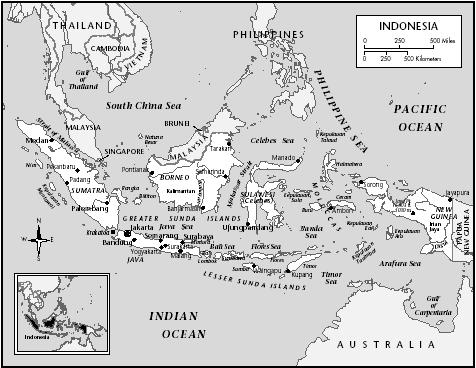
Indonesia consists of all or part of some of the world's largest islands—Sumatra, Java, most of Kalimantan (Borneo), Sulawesi (Celebes), Halmahera, and the west half of New Guinea (Papua)—and numerous smaller islands, of which Bali (just east of Java) is best known. These islands plus some others have mountain peaks of 9,000 feet (2,700 meters) or more, and there are some four hundred volcanos, of which one hundred are active. Between 1973 and 1990, for example, there were twenty-nine recorded eruptions, some with tragic consequences. Volcanic lava and ash contributed to the rich soils of upland Sumatra and all of Java and Bali, which have nurtured rice cultivation for several thousand years.
The inner islands of Java, Madura, and Bali make up the geographical and population center of the archipelago. Java, one of the world's most densely settled places (with 2,108 people per square mile [814 per square kilometer] in 1990), occupies 78 percent of the nation's land area but accounts for about 60 percent of Indonesia's population. (About the size of New York state, Java's population is equivalent to 40 percent of that of the United States.) The outer islands, which form an arc west, north, and east of the inner ones, have about 90 percent of the land area of the country but only about 42 percent of the population. The cultures of the inner islands are more homogeneous, with only four major cultural groups: the Sundanese (in West Java), the Javanese (in Central and East Java), the Madurese (on Madura and in East Java), and the Balinese (on Bali). The outer islands have hundreds of ethnolinguistic groups.
Forests of the inner islands, once plentiful, are now largely gone. Kalimantan, West Papua, and Sumatra still have rich jungles, though these are threatened by population expansion and exploitation by loggers for domestic timber use and export. Land beneath the jungles is not fertile. Some eastern islands, such as Sulawesi and the Lesser Sundas (the island chain east of Bali), also have lost forests.
Two types of agriculture are predominant in Indonesia: permanent irrigated rice farming (sawah) and rotating swidden or slash-and-burn (ladang) farming of rice, corn, and other crops. The former dominates Java, Bali, and the highlands all along the western coast of Sumatra; the latter is found in other parts of Sumatra and other outer islands, but not exclusively so. Fixed rain-fed fields of rice are prominent in Sulawesi and some other places. Many areas are rich in vegetables, tropical fruit, sago, and other cultivated or forest crops, and commercial plantations of coffee, tea, tobacco, coconuts, and sugar are found in both inner and outer islands. Plantation-grown products such as rubber, palm oil, and sisal are prominent in Sumatra, while coffee, sugar, and tea are prominent in Java. Spices such as cloves, nutmeg, and pepper are grown mainly in the outer islands, especially to the east. Maluku (formerly the Moluccas) gained its appellation the "Spice Islands" from the importance of trade in these items. Gold, tin, and nickel are mined in Sumatra, Bangka, Kalimantan, Sulawesi, and Papua for domestic and international markets, and oil and liquified natural gas (especially from Sumatra) are important exports. Numerous rivers flowing from mountainous or jungle interiors to coastal plains and ports have carried farm and forest products for centuries and have been channels for cultural communication.
Read More......Identification. The Republic of Indonesia, the world's fourth most populous nation, has 203 million people living on nearly one thousand permanently settled islands. Some two-to-three hundred ethnic groups with their own languages and dialects range in population from the Javanese (about 70 million) and Sundanese (about 30 million) on Java, to peoples numbering in the thousands on remote islands. The nature of Indonesian national culture is somewhat analogous to that of India—multicultural, rooted in older societies and interethnic relations, and developed in twentieth century nationalist struggles against a European imperialism that nonetheless forged that nation and many of its institutions. The national culture is most easily observed in cities but aspects of it now reach into the countryside as well. Indonesia's borders are those of the Netherlands East Indies, which was fully formed at the beginning of the twentieth century, though Dutch imperialism began early in the seventeenth century. Indonesian culture has historical roots, institutions, customs, values, and beliefs that many of its people share, but it is also a work in progress that is undergoing particular stresses at the beginning of the twenty-first century.
The name Indonesia, meaning Indian Islands, was coined by an Englishman, J. R. Logan, in Malaya in 1850. Derived from the Greek, Indos (India) and nesos (island), it has parallels in Melanesia, "black islands"; Micronesia, "small islands"; and Polynesia, "many islands." A German geographer, Adolf Bastian, used it in the title of his book, Indonesien, in 1884, and in 1928 nationalists adopted it as the name of their hoped-for nation.
Most islands are multiethnic, with large and small groups forming geographical enclaves. Towns within such enclaves include the dominant ethnic group and some members of immigrant groups. Large cities may consist of many ethnic groups; some cities have a dominant majority. Regions, such as West Sumatra or South Sulawesi, have developed over centuries through the interaction of geography (such as rivers, ports, plains, and mountains), historical interaction of peoples, and political-administrative policies. Some, such as North Sumatra, South Sulawesi, and East Java are ethnically mixed to varying degrees; others such as West Sumatra, Bali, and Aceh are more homogeneous. Some regions, such as South Sumatra, South Kalimantan, and South Sulawesi, share a long-term Malayo-Muslim coastal influence that gives them similar cultural features, from arts and dress to political and class stratification to religion. Upland or upriver peoples in these regions have different social, cultural, and religious orientations, but may feel themselves or be perforce a part of that region. Many such regions have become government provinces, as are the latter three above. Others, such as Bali, have not.
Read More......Copyright@eblog-culture 2008 eblog-culture | Designed by eblog-culture